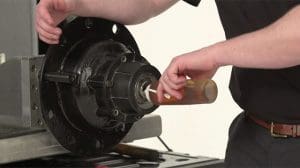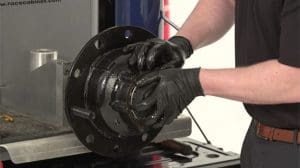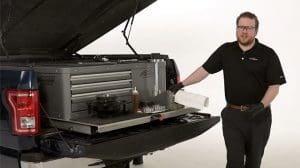Designed to increase simplicity and safety, the STEMCO QWIKTIE tie rod assembly offers a highly adaptable solution that can accommodate a wide range of straight tie rod lengths. Universal for over 80% of the tie rod lengths and styles on the market, QWIKTIE features different color attributes for easy identification and accurate installation.
The purpose of this tech tip is to inform customers of the proper installation methods, and guidelines for the use, inspection, and replacement of STEMCO QWIKTIE tie rod assemblies. We will be referencing the following STEMCO PDFs:
General Use and Inspection
- QWIKTIE is approved for the following vehicle applications: interstate, on-highway, and limited off-highway.
- STEMCO does not approve QWIKTIE in-vehicle applications that include more than 20% off-highway vehicle use and/or exceeds legal weight limitations.
- Refer to the axle manufacturer’s instructions as a primary guide for inspection interval service recommendations.
- Follow STEMCO’s Guidelines for QWIKTIE rod assembly (01-577-0120) for installation, removal, and inspection.
- It is important to identify early signs of excessive play, which indicates wear. Over time, suspension wear is accelerated and serious damage can occur if not attended early in the preventive maintenance.
Visual Inspection
- Castle nut should be tight and the cotter pin should be secured.
- On non-STEMCO tie rod ends, the end of the rod should not be visible through the relief cuts.
- Neither the seal or grease boot should show signs of wear. Rod end boot should cover the ball joint completely and not show any signs of damage. Zerk fittings should not show any signs of grease leakage.
- The clamp should be secure and in good condition.
- Tie rod should be straight and show no signs of damage.
Manual Inspection
- Tie rod should turn freely in both directions.
- Never attempt to repair a tie rod tube.
- If any of these conditions are not met, replace the entire tie rod assembly.
- After a visual inspection is completed, proceed to check for vertical and horizontal measurements with a dial indicator.
Dial Indicator Inspection
- Park vehicle with wheels in a straight-ahead steering position. Turn engine off, apply parking brakes, and chock wheels to ensure safety.
- Make sure the castle nuts and clamps are tight before starting.
Horizontal Play
Place the dial indicator base on the side of the steering spindle with the pointer on the housing of the tie rod end. Push or pull the rod end to obtain horizontal movement. The play should not be more than 0.030”. If movement is more than 0.030”, the tie rod end should be replaced. If the play is over 0.060” (1/16”), the truck should be taken out of service until the repair is complete.
Vertical Play
Place the base of dial indicator on the bottom of the steering spindle with the pointer on the
housing of the tie rod end. Compress to obtain a vertical movement. The play should not be more
than 0.030”. If movement is more than 0.030”, the tie-rod end should be replaced. If play is over 0.060” (1/16”), the truck should be taken out of service until the repair is complete.
- Do not use a pry bar to obtain these readings
- STEMCO recommends replacing both the left and right tie rod ends at the same repair.
Additional Inspection Guidelines
- Replace QWIKTIE rod assembly if any of the following are found:
- Inspect for damage that can lead to significant axle and steering repairs including dents, bending or deformation and other unusual marks from external contact.
- Inspect for seal damage, worn ball socket(s) or loose fasteners.
- Inspect for adjustment, missing, loose or bent steer axle stops.
- Check wheel alignment if you experience excessive steering effort, vehicle wander, or uneven and/or excessive tire wear.
Replacement Recommendations:
- STEMCO recommends replacement of a QWIKTIE for any out of specification condition as noted in the Guidelines for QWIKTIE rod assembly (01-577-0120).
- If a vehicle is involved in an accident creating a side load on the axle (e.g. crash, curb impact, or any significant impact), especially when the vehicle is loaded at or above GVWR, replace the QWIKTIE.
- If a bent wheel, hub, or spindle is found on the steer axle, STEMCO strongly recommends replacing the complete QWIKTIE rod assembly and performing a thorough inspection of the axle and steering components.
REMOVAL
- Use standard shop procedure to work on the truck.
- Remove both cotter pins.
- Loosen both tie rod end castle nuts
- Hit each castle nut with a hammer until the tie rod ends are loose. Both castle nuts should suspend the tie rod assembly.
- If the tie rod end does not release, call for technical support. Do not damage the steering spindle arm.
- Once the assembly is loose and held by the castle nuts, continue removing the nuts and lower the assembly
INSTALLATION
- Measure the minor diameter of the removed tie rod end to determine the correct QWIKTIE rod assembly part number to use.
- From the old assembly measure zerk to zerk length.
- Set the new QWIKTIE rod assembly to the approximate zerk to zerk length of the old assembly.
- When setting the approximate length, assure both tie rod ends have the same length thread exposure A=A (equal lengths on both left and right tie rod ends.)
- Tie rod assembly tube adjustment: the limit indicator groove on the QWIKTIE rod ends should never be visible past the end of the tube.
- With the clamps facing the rear of the truck and the nuts in the down position, verify the Blue clamp is to the driver’s right hand.
- Insert the stud threads into the steering spindle.
- Loosely thread on the castle nut. Repeat with the other side so that the assembly is suspended.
- Tighten each castle nut until snug and then torque each side to 250 ft. lbs
- Move the castle nut slots to the closest cotter pin hole.
- Insert the cotter pin and bend to lock in place.
- Never reuse cotter pins
- STEMCO QWIKTIE rod assemblies are pre lubricated.
- Perform a wheel alignment to set the toe adjustment to the manufacturer’s specification.
- STEMCO recommends using the STEMCO Equipment Alignment System to perform the alignment.
- After adjusting the toe to the manufacturer’s specification, tighten both assembly tube clamp bolts over the QWIKTIE rod assembly tube to 60 ft-lb torque.
If you would like more information on our STEMCO QWIKTIE tie rod assembly, visit our product page.
To access our full library of Tech Tips, click here.
For in-depth articles covering industry news and trends, product spotlights, case studies, customer insights, and “thought leadership” topics from STEMCO professionals, visit The Wheelhouse Blog.






